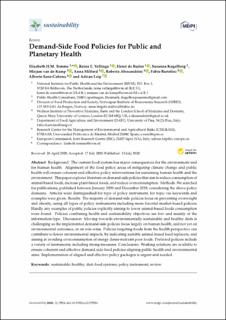| dc.contributor.author | Temme, Elisabeth H.M. | |
| dc.contributor.author | Vellinga, Reina E. | |
| dc.contributor.author | de Ruiter, Henri | |
| dc.contributor.author | Kugelberg, Susanna | |
| dc.contributor.author | van de Kamp, Mirjam | |
| dc.contributor.author | Milford, Anna Birgitte | |
| dc.contributor.author | Alessandrini, Roberta | |
| dc.contributor.author | Bartolini, Fabio | |
| dc.contributor.author | Sanz-Cobena, Alberto | |
| dc.contributor.author | Leip, Adrian | |
| dc.date.accessioned | 2021-01-29T13:10:36Z | |
| dc.date.available | 2021-01-29T13:10:36Z | |
| dc.date.created | 2020-09-18T13:53:11Z | |
| dc.date.issued | 2020-07-23 | |
| dc.identifier.citation | Sustainability. 2020, 12 (15), 1-19. | en_US |
| dc.identifier.issn | 2071-1050 | |
| dc.identifier.uri | https://hdl.handle.net/11250/2725367 | |
| dc.description.abstract | Background: The current food system has major consequences for the environment and for human health. Alignment of the food policy areas of mitigating climate change and public health will ensure coherent and effective policy interventions for sustaining human health and the environment. Thispaperexploresliteratureondemand-sidepoliciesthataimtoreduceconsumptionof animal-basedfoods,increaseplant-basedfoods,andreduceoverconsumption. Methods:Wesearched for publications, published between January 2000 and December 2019, considering the above policy domains. Articles were distinguished for type of policy instrument, for topic via keywords and examples were given. Results: The majority of demand-side policies focus on preventing overweight and obesity, using all types of policy instruments including more forceful market-based policies. Hardly any examples of public policies explicitly aiming to lower animal-based foods consumption were found. Policies combining health and sustainability objectives are few and mainly of the information type. Discussion: Moving towards environmentally sustainable and healthy diets is challenging as the implemented demand-side policies focus largely on human health, and not yet on environmental outcomes, or on win-wins. Policies targeting foods from the health perspective can contribute to lower environmental impacts, by indicating suitable animal-based food replacers, and aiming at avoiding overconsumption of energy dense-nutrient poor foods. Preferred policies include a variety of instruments, including strong measures. Conclusions: Working solutions are available to ensure coherent and effective demand side food policies aligning public health and environmental aims. Implementation of aligned and effective policy packages is urgent and needed. | en_US |
| dc.description.sponsorship | © 2020 by the authors | en_US |
| dc.language.iso | eng | en_US |
| dc.publisher | MDPI, Basel, Switzerland | en_US |
| dc.rights | Navngivelse 4.0 Internasjonal | * |
| dc.rights.uri | http://creativecommons.org/licenses/by/4.0/deed.no | * |
| dc.title | Demand-Side Food Policies for Public and Planetary Health | en_US |
| dc.type | Peer reviewed | en_US |
| dc.type | Journal article | en_US |
| dc.description.version | publishedVersion | en_US |
| dc.source.pagenumber | 1-19 | en_US |
| dc.source.volume | 12 | en_US |
| dc.source.journal | Sustainability | en_US |
| dc.source.issue | 15 | en_US |
| dc.identifier.doi | 10.3390/su12155924 | |
| dc.identifier.cristin | 1831201 | |
| dc.relation.project | Norges forskningsråd: 267858 | en_US |
| dc.source.articlenumber | 5924 | en_US |
| cristin.ispublished | true | |
| cristin.fulltext | original | |
| cristin.qualitycode | 1 | |

